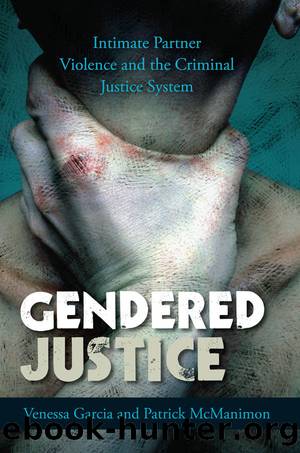Gendered Justice by Garcia Venessa;McManimon Patrick; & Patrick McManimon

Author:Garcia, Venessa;McManimon, Patrick; & Patrick McManimon
Language: eng
Format: epub
Publisher: Rowman & Littlefield Publishers
Published: 2011-08-15T00:00:00+00:00
NO-DROP POLICIES AND EVIDENCE-BASED PROSECUTION
Under no-drop policies prosecutors do not rely on the victimâs testimony to move cases to trial. Instead prosecutors rely on other evidence to reach their burden of proof. Prosecutors adopted evidence-based prosecution policies that required the police take detailed statements from victims during the course of the initial and subsequent investigations. Prosecutors use 911 tapes, photographs, medical records, and statements made to medical personnel concerning the injuries, as well as information gathered by social workers, as evidence to build cases against abusers. The victimsâ statements are authenticated by investigators and the police, medical personnel, and social workers.
To follow prosecutorial dictates, the police and 911 operators are often trained in how to question victims and callers in order to gain testimonial evidence (Jaros, 2005). Of course, defense attorneys claim that these statements violate the hearsay rules and are inadmissible in court. In 1995, the court held that an excited utterance serves as an exception to the hearsay rule because the victim or witness provides the statement under the stress of excitement (State v. Sims, 1995); however, when the victim or witness has time to reflect on the statement, the stress of excitement is called into question and the statement can no longer be deemed an excited utterance (State v. Barnes, 1996). The courts have ruled that excited utterances are not likely given to incriminate the defendant but are reasonably related to the victimâs treatment. Further, corroboration, which tends to be higher for intimate partner violence cases, is often provided via statements by police, doctors, and counselors. The totality of the circumstances provide for the hearsay exception.
The courts continue to hear cases relevant to the excited utterance exception. Almost a decade following State v. Sims and State v. Barnes, the United States Supreme Court further clarified this exception in Crawford v. Washington (2004). In this case, the Court examined the confrontation clause and ruled that any statement made by a victim or witness that served as a testimonial statement in lieu of the absent victim or witness is a violation of the defendantâs Sixth Amendment right to cross-examine the evidence. The Court determined that statements made with the intention of prosecuting the defendant must be supported with court testimony. As mentioned earlier, many police and 911 dispatchers have been trained to question the caller in a way that the information gathered can be used as evidence in court. As the U.S. Supreme Court did not define what constituted testimonial statements, lower courts are left to make this determination. As a result, 911 calls have been redefined from excited utterances to testimonial statements that require victim cooperation (People v. Moscat, 2004). As pointed out by public defender Jaros (2005), this interpretation can serve as a severe blow to evidence-based prosecution.
The success of evidence-based prosecution relies on the collaboration between the prosecutor and the police. Specialized intimate partner violence caseloads or units were successfully developed throughout the United States to address the revolving-door syndrome of family abuse and victimization. Specialized units do not follow one model.
Download
This site does not store any files on its server. We only index and link to content provided by other sites. Please contact the content providers to delete copyright contents if any and email us, we'll remove relevant links or contents immediately.
Cecilia; Or, Memoirs of an Heiress — Volume 1 by Fanny Burney(32023)
Cecilia; Or, Memoirs of an Heiress — Volume 3 by Fanny Burney(31437)
Cecilia; Or, Memoirs of an Heiress — Volume 2 by Fanny Burney(31382)
The Great Music City by Andrea Baker(30641)
We're Going to Need More Wine by Gabrielle Union(18607)
All the Missing Girls by Megan Miranda(14602)
Pimp by Iceberg Slim(13718)
Bombshells: Glamour Girls of a Lifetime by Sullivan Steve(13667)
Fifty Shades Freed by E L James(12886)
Talking to Strangers by Malcolm Gladwell(12816)
Norse Mythology by Gaiman Neil(12789)
For the Love of Europe by Rick Steves(11333)
Crazy Rich Asians by Kevin Kwan(8861)
Mindhunter: Inside the FBI's Elite Serial Crime Unit by John E. Douglas & Mark Olshaker(8665)
The Lost Art of Listening by Michael P. Nichols(7125)
Enlightenment Now: The Case for Reason, Science, Humanism, and Progress by Steven Pinker(6852)
The Four Agreements by Don Miguel Ruiz(6284)
Bad Blood by John Carreyrou(6255)
Weapons of Math Destruction by Cathy O'Neil(5801)
